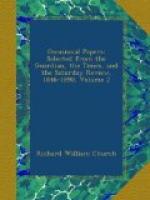fountains, and to bring him from it filled more than
ever with wonder at its astonishing phenomena, to
protest against the poverty and shallowness of the
most ambitious and confident of these attempts.
They leave the historical Character which they pourtray
still unsounded, its motives, objects, and feelings
absolutely incomprehensible. He accepts the method
to reverse the product. “Look at Christ
historically,” people say; “see Him as
He really was.” The answer here is, “Well,
I will look at Him with whatever aid a trained historical
imagination can look at Him. I accept your challenge;
I admit your difficulties. I will dare to do
what you do. I will try and look at the very facts
themselves, with singleness and ‘innocence of
the eye,’ trying to see nothing more than I
really see, and trying to see all that my eye falls
on. I will try to realise indeed what is recorded
of Him. And
this is what I see. This
is the irresistible impression from the plainest and
most elementary part of the history, if we are to accept
any history at all. A miracle could not be more
unlike the order of our experience than the Character
set before us is unique and unapproachable in all
known history. Further, all that makes the superiority
of the modern world to the ancient, and is most permanent
and pregnant with improvement in it, may be traced
to the appearance of that Character, and to the work
which He planned and did. You ask for a true picture
of Him, drawn with freedom, drawn with courage; here,
if you dare look at it, is what those who wrote of
Him showed Him to be. Renan has tried to draw
this picture. Take the Gospels as they stand;
treat them simply as biographies; look, and see, and
think of what they tell, and then ask yourself about
Renan’s picture, and what it looks like when
placed side by side with the truth.”
This, as we have ventured to express it in our own
words, seems to be the writer’s position.
It is at any rate the effect of his book, to our minds.
The inquiry, it must always be remembered, is a preliminary
one, dealing, as he says, with the easiest and obvious
elements of the problem; and much that seems inadequate
and unsatisfactory may be developed hereafter.
He starts from what, to those who already have the
full belief, must appear a low level. He takes,
as it will be seen, the documents as they stand.
He takes little more than the first three Gospels,
and these as a whole, without asking minute questions
about them. The mythical theory he dismisses
as false to nature, in dealing with such a Character
and such results. He talks in his preface of
“critically weighing” the facts; but the
expression is misleading. It is true that we
may talk of criticism of character; but the words
naturally suggest that close cross-questioning of documents
and details which has produced such remarkable results
in modern investigations; and of this there is none.
It is a work in no sense of criticism; it is a work
of what he calls the “trained historical imagination”;




